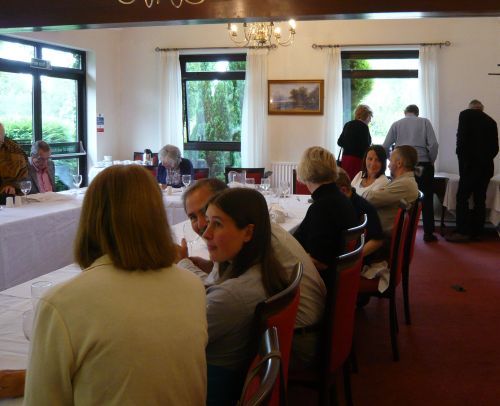
Sunday 30th September 2012 - Whitbreads Meet Up

A rare thing happened today. I was invited to a gathering of The Whitbread clan at Salisbury; descendants all of Hannah Coles & James Whitbread who married in Chitterne in 1849. Rare because athough I meet lots of folk researching their Chitterne families in ones or twos when they call here, I have never until this day met a whole bunch of one family at once.
It was fascinating, and surrendipitous to have been contacted by PL from Guernsey, who organises these gatherings of his extended family every two years, and to have been included. Why? Because H & W my two intrepid family researcher friends have recently been casting their expert eyes over this very family. It was almost like fate when PL's email came in, I couldn't believe it, nor could H & W.
It was Hannah Coles we were interested in. She was born Hannah Hart in Chitterne in 1812 into a family which called itself by two names! I have to say this family caused us a lot of grief, so much so that their story became the Hart - Coles Saga. Until earlier this year I believed the members were two separate families: The Harts and The Coles. Not so. H & W discovered they all had two names, and each person appeared in my family lists twice, which had caused no end of bother.
We still haven't got to the bottom of why they did this. But in the course of trying to solve the question some interesting facts came to light, which I was able to relate to the Whitbread assembly today. First, Hannah's father, William Hart alias Coles born Chitterne in 1785, after several convctions for larceny and manslaughter was transported to Tasmania in 1837 for seven years (which meant you were there for life, there was no return ticket). Meanwhile, back in Chitterne, Hannah was busy producing daughters, four of them between 1836 and 1846, all with no known father. Her girls were all registered at birth as base born 'female Harts' and later baptised as Frances, Sarah, Elizabeth and Mary Coles.
In 1849 things started to look up for Hannah. She married James Whitbread from Edington and gave birth to a son William James Whitbread in Chitterne in 1852. But once again tragedy overcame her when one year later her husband was killed in an accident, but Hannah found a kind benefactor in Thomas Flower, a farmer from Knook, and she spent the rest of her working life cooking and housekeeping for him.
The Whitbread family members I met today were all descended from Hannah's son, William James Whitbread. In contrast to William Hart alias Coles, his grandfather, this William rose to be an Inspector with Salisbury City Police after a career in the army. But evenso his life did not run smoothly. There was to be yet another mystery for H & W to solve.
In 1877 William James Whitbread married a widow, Mary Emma Porter, and a year later Mary Emma gave birth to a daughter Gertrude and then disappeared from the family. None of the family ever knew what had happened, whether she had died or run off or what, and Gertrude was never told who her mother was. In 1881 William James, calling himself a widower, married Alice Phoebe Dixon and Alice brought Gertude up alongside the children she had with William James .
I knew when I told H & W this story it would intrigue them, and sure enough they came up with most of the goods. I can't praise their expertise enough, they are brilliant! So what do they think happened to Mary Emma?
They pretty soon found that the only match for her was Emma Mary Porter, born in Woolwich in 1839 as Emma Mary Hall into an army family and married to a Joseph Porter in 1861. Joseph was a member of the Royal Horse Artillery and he and Emma had 6 children, three of whom had died. In the 1871 census Joseph and Emma were living in Devonport, the same town where William James Whitbread was also posted in the Royal Artillery. So this must be how Emma and William met. But why when Emma married him in 1877 did she call herself a widow? And where were her three sons?
At the moment H & W's theory is that Emma must have thought that Joseph had been killed or missing in action before she married William James. But this was not the case because in the 1891 census they found Emma back living with Joseph, who had by now been promoted to captain. Backing up their theory is some information from PL about his grandfather's service in the Salisbury Police. It seems that William James resigned from the Police in June 1880, and rejoined 6 months later in February 1881, so could this have been when he and Emma discovered that Joseph was still alive? William James would have been in a rather dodgy situation as a bigamously married serving police officer! This is all theory, I must just say, but what a story! And here's another question: Why did William James say he was a widower when he married Alice?
Access to Joseph Porter's army service record would be good at this point but H & W have had no luck here, and fear that the records have been lost. So we may never know what really happened.
Friday 21st September 2012 - Wildlife Rescue
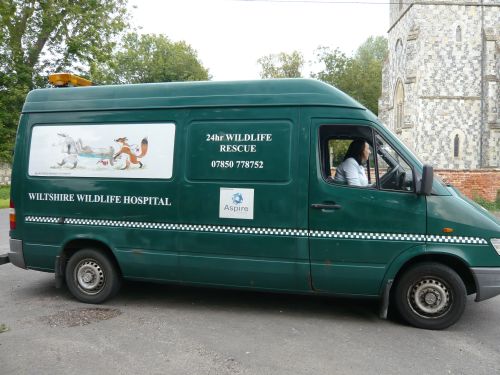
The Kneeler Group at the Village Hall were interested witnesses to the transfer of a wounded badger from a car boot to the ambulance pictured above this morning. None of us even knew that such an organisation as the Wiltshire Wildlife Hospital existed before today, let alone that they had an animal ambulance. The ambulance had come from north of Salisbury and the man with the badger in his car had come from Crockerton. Just why they had made the transfer in Chitterne I have no idea; perhaps we were a convenient midway spot.
Sunday 9th September 2012 - The Chitterne Mafia
All right, calm down, its not a present day Mafia! This is the title given to some Chitterne history by my good friends H & W (Holmes and Watson), who are brilliant at digging up historical facts and using them to paint a picture of life in Chitterne in the olden days.
Lately, they have discovered a trio of Chitterne men who were transported to Tasmania for their misdeeds. Their latest find concerns a certain John Ashley born in Chitterne in 1800, who we thought had died between 1834 and 1841 because he does not appear with his wife Mary Goodfellow either in the 1841 Chitterne census or later. Now it seems we were wrong!
I am going to let Holmes & Watson tell the story because it made me laugh and I wanted, with their permission, to share it with you:
"John Ashley, it turns out is another member of the Chitterne Mafia, for there he is in 1836, in black and white, charged with stealing fowl, along with a few chums, most of whom I know not, but you can’t have it all, can you? This is serious back in those days – larceny is frowned upon, and to prove it, the beak hands down swift justice – 7 years transportation! And so he finds himself in the very same spot as William Hart and Benjamin Moody (no relation to our AM as far as I know!) would be the following year, there in the prison hulk Leviathan in Portsmouth harbour.
Time passes, the good ship Sarah hoves into view and off sails John on his long journey to the very same destination as our other two desperadoes William and Benjamin, arriving eventually in Tasmania in early 1837. Yet he is not idle on the voyage, no indeed – not for him the typical tourist ways, lounging on the poop deck (or wherever, I’m not nautical at all!) topping up his sun-tan. For while he is aboard, there are knaves planning dirty deeds, maybe having read about and digested the exploits of our hero Long John Silver – yes, there are mutterings amongst the more adventurous, and talk of mutiny. Visions of Captain Bligh, eh – “This is mutiny, Mr. Christian, mutiny!” Now John wants no part of this, so informs the proper authorities and the whole thing is nipped in the bud.
What John’s shipmates thought of his actions we can only surmise, though I would think that he wouldn’t be the most popular person aboard – still, the powers that be are suitably pleased, realising what a grand chap he is, and he is commended for his actions, and seems to have been rewarded by being made some sort of policeman in Tasmania.
Sadly, it’s not long before this is behind him and he is once more in trouble and dismissed from the force in disgrace. What can he have done, I hear you cry! What indeed! For he has been caught, and here I dread to think what his dear wife Mary would think of him back in Chitterne, yes caught with a drunken female in his custody – I leave it to you to imagine the scene, but it strikes me that it’s perhaps not the sort of thing to discuss, or even think about, in polite society. And from then on, it does seem as if things go down-hill for John, for within a short while he is back with the rest of the convicts, at one time being clasped in chains and given a six month sentence of hard labour. Alas, those heady days of being a person of standing seem so far away now, and all because of a drunken floozy!
All these details are found down in the Tasmania archives, same as William and Benjamin."
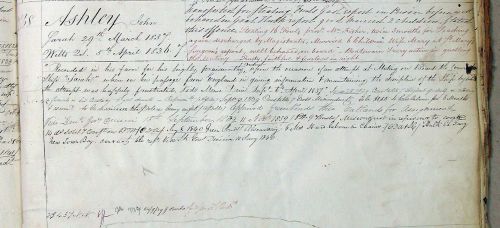
With grateful thanks to H & W for making village history such fun!
Thursday 6th September 2012 - Kneeler 22
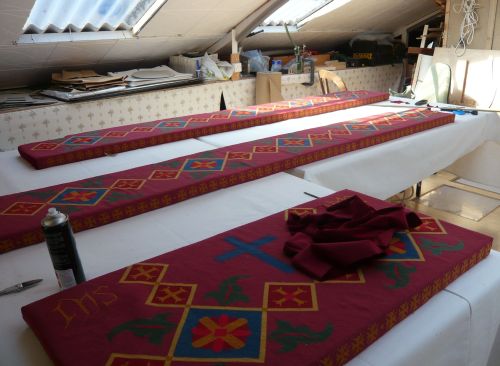
My blog holiday's over so what's new? Well, I never thought I would get to see our kneelers being made up, but that's what happened yesterday after a phone call from Angelo de Cortes, the upholsterer, inviting me to take photos of him at work to put in the kneeler book. Have I mentioned that before? In case not, we are going to record our Kneeler Project in book form, that is if I get my act together sufficiently to produce the goods. But more of that later, back to yesterday's visit.

I found Angelo's premises, a shop and adjoining workshop called Cambrica almost at the end of Winchester Street in Saisbury, without problem. The shop had a closed notice that directed me to the workshop next door. I walked into the workshop between various wooden chair frames and a vast array of hanging pattern books to a larger room beyond. I was welcomed in and invited to inspect the kneelers in the upstairs workshop while he concluded some business below.
This gave me the chance to take the photo above with the sunlight streaming through the skylights in the attic, where the hard work gets done. My goodness what a challenge we had set him! The tables containing our three altar rail kneelers almost filled the main part of the room; laid out like this and wrapped around their shaped foam fillers the kneelers looked magnificent! Angelo worked and moved around the tables sitting on a wheeled office chair.
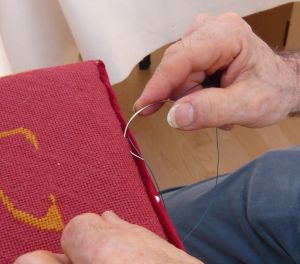
He had already stitched the corners and was using red vevet material to complete the sides which will be hidden at the back next to the altar rail. He explained that he also needed to add the velvet at the sides where we had recently added an extra inch of stitching because the centre section canvaswork was not large enough to cover its foam pad. What a relief that he is able to overcome this setback. It is this section he is stitching in the other picture. He is using Barbour's Waxed Thread, a very strong waxed slipping thread, in a curved needle. I was surprised to see that the thread was blue, but in his skillful hands the stitches became invisible so you wouldn't know they were blue when it was finished. The job of pulling the thread through the closely stitched canvas is tough on the fingers and he joked that the red of the material wasn't just red dye! If we complained about sore fingers after a day stitching our kneelers we should think on the poor upholsterer! When the altar rail kneelers are done he still has scores more little kneelers to do.
PS: On reflection I think the challenge we set ourselves to make those 3 million+ stitches was far and away the greater challenge of the two. Unlike Angelo, we were unpaid. We did it for love!